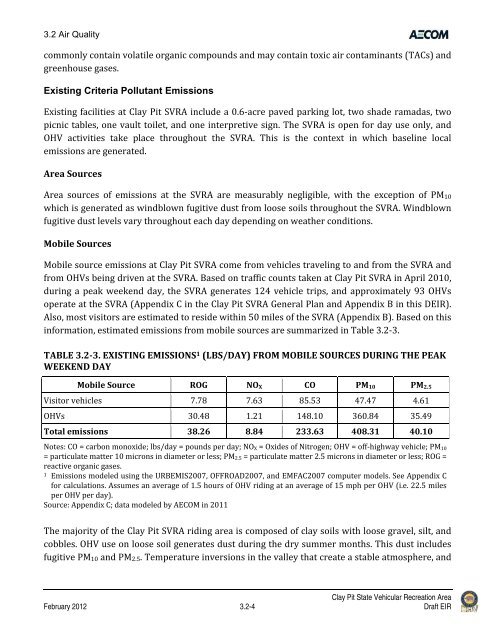Draft Environmental Impact Report - California Off Highway Vehicle ...
Draft Environmental Impact Report - California Off Highway Vehicle ...
Draft Environmental Impact Report - California Off Highway Vehicle ...
Create successful ePaper yourself
Turn your PDF publications into a flip-book with our unique Google optimized e-Paper software.
3.2 Air Quality<br />
commonly contain volatile organic compounds and may contain toxic air contaminants (TACs) and<br />
greenhouse gases.<br />
Existing Criteria Pollutant Emissions<br />
Existing facilities at Clay Pit SVRA include a 0.6‐acre paved parking lot, two shade ramadas, two<br />
picnic tables, one vault toilet, and one interpretive sign. The SVRA is open for day use only, and<br />
OHV activities take place throughout the SVRA. This is the context in which baseline local<br />
emissions are generated.<br />
Area Sources<br />
Area sources of emissions at the SVRA are measurably negligible, with the exception of PM10<br />
which is generated as windblown fugitive dust from loose soils throughout the SVRA. Windblown<br />
fugitive dust levels vary throughout each day depending on weather conditions.<br />
Mobile Sources<br />
Mobile source emissions at Clay Pit SVRA come from vehicles traveling to and from the SVRA and<br />
from OHVs being driven at the SVRA. Based on traffic counts taken at Clay Pit SVRA in April 2010,<br />
during a peak weekend day, the SVRA generates 124 vehicle trips, and approximately 93 OHVs<br />
operate at the SVRA (Appendix C in the Clay Pit SVRA General Plan and Appendix B in this DEIR).<br />
Also, most visitors are estimated to reside within 50 miles of the SVRA (Appendix B). Based on this<br />
information, estimated emissions from mobile sources are summarized in Table 3.2‐3.<br />
TABLE 3.23. EXISTING EMISSIONS 1 (LBS/DAY) FROM MOBILE SOURCES DURING THE PEAK<br />
WEEKEND DAY<br />
Mobile Source ROG NOX CO PM10 PM2.5<br />
Visitor vehicles 7.78 7.63 85.53 47.47 4.61<br />
OHVs 30.48 1.21 148.10 360.84 35.49<br />
Total emissions 38.26 8.84 233.63 408.31 40.10<br />
Notes: CO = carbon monoxide; lbs/day = pounds per day; NOX = Oxides of Nitrogen; OHV = off‐highway vehicle; PM10<br />
= particulate matter 10 microns in diameter or less; PM2.5 = particulate matter 2.5 microns in diameter or less; ROG =<br />
reactive organic gases.<br />
1 Emissions modeled using the URBEMIS2007, OFFROAD2007, and EMFAC2007 computer models. See Appendix C<br />
for calculations. Assumes an average of 1.5 hours of OHV riding at an average of 15 mph per OHV (i.e. 22.5 miles<br />
per OHV per day).<br />
Source: Appendix C; data modeled by AECOM in 2011<br />
The majority of the Clay Pit SVRA riding area is composed of clay soils with loose gravel, silt, and<br />
cobbles. OHV use on loose soil generates dust during the dry summer months. This dust includes<br />
fugitive PM10 and PM2.5. Temperature inversions in the valley that create a stable atmosphere, and<br />
Clay Pit State Vehicular Recreation Area<br />
February 2012 3.2-4 <strong>Draft</strong> EIR








